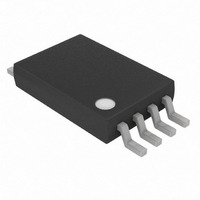DS2781E+ Maxim Integrated Products, DS2781E+ Datasheet - Page 29

DS2781E+
Manufacturer Part Number
DS2781E+
Description
IC FUEL GAUGE BATT 8TSSOP
Manufacturer
Maxim Integrated Products
Datasheet
1.DS2781E.pdf
(31 pages)
Specifications of DS2781E+
Function
Fuel, Gas Gauge/Monitor
Battery Type
Lithium-Ion (Li-Ion), Lithium-Polymer (Li-Pol)
Voltage - Supply
2.5 V ~ 10 V
Operating Temperature
-40°C ~ 85°C
Mounting Type
Surface Mount
Package / Case
8-TSSOP
Operating Supply Voltage
2.5 V to 10 V
Supply Current
70 uA
Maximum Operating Temperature
+ 85 C
Minimum Operating Temperature
- 40 C
Charge Safety Timers
No
Mounting Style
SMD/SMT
Temperature Monitoring
Yes
Lead Free Status / RoHS Status
Lead free / RoHS Compliant
1-Wire SIGNALING
The 1-Wire bus requires strict signaling protocols to ensure data integrity. The four protocols used by the DS2781
are as follows: the initialization sequence (reset pulse followed by presence pulse), write 0, write 1, and read data.
All of these types of signaling except the presence pulse are initiated by the bus master.
The initialization sequence required to begin any communication with the DS2781 is shown in Figure 26. A
presence pulse following a reset pulse indicates that the DS2781 is ready to accept a net address command. The
bus master transmits (Tx) a reset pulse for t
(Rx). The 1-Wire bus line is then pulled high by the pullup resistor. After detecting the rising edge on the DQ pin,
the DS2781 waits for t
Figure 26. 1-Wire Initialization Sequence
WRITE-TIME SLOTS
A write-time slot is initiated when the bus master pulls the 1-Wire bus from a logic-high (inactive) level to a logic-low
level. There are two types of write-time slots: write 1 and write 0. All write-time slots must be t
1μs minimum recovery time, t
60μs (between 2μs and 6μs for overdrive speed) after the line falls. If the line is high when sampled, a write 1
occurs. If the line is low when sampled, a write 0 occurs (see Figure 27). For the bus master to generate a write 1
time slot, the bus line must be pulled low and then released, allowing the line to be pulled high within 15μs (2μs for
overdrive speed) after the start of the write-time slot. For the host to generate a write 0 time slot, the bus line must
be pulled low and held low for the duration of the write-time slot.
READ-TIME SLOTS
A read-time slot is initiated when the bus master pulls the 1-Wire bus line from a logic-high level to a logic-low level.
The bus master must keep the bus line low for at least 1μs and then release it to allow the DS2781 to present valid
data. The bus master can then sample the data t
slot, the DS2781 releases the bus line and allows it to be pulled high by the external pullup resistor. All read-time
slots must be t
information.
DQ
SLOT
in duration with a 1μs minimum recovery time, t
LINE TYPE LEGEND:
PDH
and then transmits the presence pulse for t
t
BUS MASTER ACTIVE LOW
BOTH BUS MASTER AND
DS2781 ACTIVE LOW
RSTL
REC
, between cycles. The DS2781 samples the 1-Wire bus line between 15μs and
t
PDH
RSTL
. The bus master then releases the line and goes into receive mode
RDV
from the start of the read-time slot. By the end of the read-time
29 of 31
t
PDL
DS2781 ACTIVE LOW
RESISTOR PULLUP
PDL
REC
t
.
RSTH
, between cycles. See Figure 27 for more
SLOT
in duration with a
PACK+
PACK-











